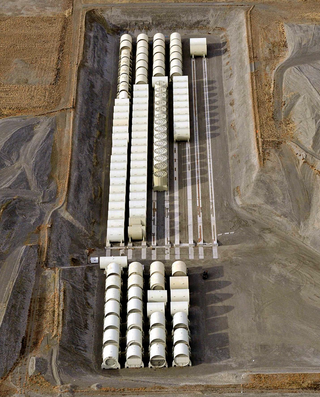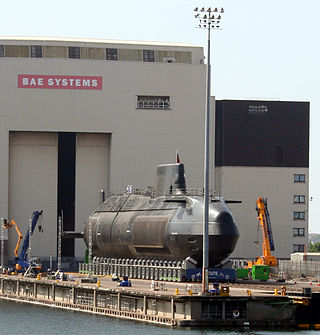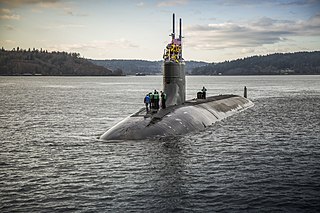
The Los Angeles class of submarines are nuclear-powered fast attack submarines (SSN) in service with the United States Navy. Also known as the 688 class after the hull number of lead vessel USS Los Angeles (SSN-688), 62 were built from 1972 to 1996, the latter 23 to an improved 688i standard. As of 2022, 26 of the Los Angeles class remain in commission—more than any other class in the world—and they account for more than half of the U.S. Navy's 50 fast attack submarines.

The Seawolf class is a class of nuclear-powered, fast attack submarines (SSN) in service with the United States Navy. The class was the intended successor to the Los Angeles class, and design work began in 1983. A fleet of 29 submarines was to be built over a ten-year period, but that was reduced to 12 submarines. The end of the Cold War and budget constraints led to the cancellation of any further additions to the fleet in 1995, leaving the Seawolf class limited to just three boats. This, in turn, led to the design of the smaller Virginia class. The Seawolf class cost about $3 billion per unit, making it the most expensive United States Navy fast attack submarine and second most expensive submarine ever, after the French Triomphant-class nuclear-powered ballistic missile submarines.

United States naval reactors are nuclear reactors used by the United States Navy aboard certain ships to generate the steam used to produce power for propulsion, electric power, catapulting airplanes in aircraft carriers, and a few more minor uses. Such naval nuclear reactors have a complete power plant associated with them. All U.S. Navy submarines and supercarriers built since 1975 are nuclear-powered by such reactors. There are no commissioned conventional (non-nuclear) submarines or aircraft carriers left in the U.S. Navy, since the last conventional carrier, USS Kitty Hawk, was decommissioned in May 2009. The U.S. Navy had nine nuclear-powered cruisers with such reactors also, but they have since been decommissioned. Reactors are designed by a variety of contractors, then developed and tested at one of several government owned and prime contractor-operated facilities: Bettis Atomic Power Laboratory in West Mifflin, Pennsylvania and its associated Naval Reactors Facility in Idaho, and Knolls Atomic Power Laboratory in Niskayuna, New York and its associated Kesselring site in West Milton, New York, all under the management of the office of Naval Reactors. Sometimes there were full-scale nuclear-powered prototype plants built at the Naval Reactors Facility, Kesselring, and Windsor to test the nuclear plants, which were operated for years to train nuclear-qualified sailors.

USS Seawolf (SSN-21), is a nuclear-powered fast attack submarine and the lead ship of her class. She is the fourth submarine of the United States Navy named for the seawolf, a solitary fish with strong, prominent teeth that give it a savage look.

USS Jimmy Carter (SSN-23) is the third and final Seawolf-class nuclear-powered fast-attack submarine in the United States Navy. Commissioned in 2005, she is named for the 39th president of the United States, Jimmy Carter, the only president to have qualified on submarines. The only submarine to be named for a living president, Jimmy Carter is also one of the few vessels, and only the third submarine of the US Navy, to be named for a living person. Extensively modified from the original design of her class, she is sometimes described as a subclass unto herself.

USS Narwhal (SSN-671), a unique submarine, was the third vessel of the United States Navy to be named for the narwhal, a gray and white arctic whale with a unicorn-like, ivory tusk.

USS Cheyenne (SSN-773), the final Los Angeles-class submarine, is the third ship of the United States Navy to be named for Cheyenne, Wyoming. The contract to build her was awarded to Newport News Shipbuilding and Dry Dock Company in Newport News, Virginia on 28 November 1989 and her keel was laid down on 6 July 1992. She was launched on 16 April 1995 sponsored by Mrs. Ann Simpson, wife of Wyoming Senator Alan K. Simpson, and commissioned on 13 September 1996, with Commander Peter H. Ozimik in command. Cheyenne transferred to her homeport of Pearl Harbor, Hawaii, in 1998.

A nuclear submarine is a submarine powered by a nuclear reactor, but not necessarily nuclear-armed. Nuclear submarines have considerable performance advantages over "conventional" submarines. Nuclear propulsion, being completely independent of air, frees the submarine from the need to surface frequently, as is necessary for conventional submarines. The large amount of power generated by a nuclear reactor allows nuclear submarines to operate at high speed for long periods, and the long interval between refuelings grants a range virtually unlimited, making the only limits on voyage times being imposed by such factors as the need to restock food or other consumables.
The S1W reactor was the first prototype naval reactor used by the United States Navy to prove that the technology could be used for electricity generation and propulsion on submarines.

Nuclear marine propulsion is propulsion of a ship or submarine with heat provided by a nuclear reactor. The power plant heats water to produce steam for a turbine used to turn the ship's propeller through a gearbox or through an electric generator and motor. Nuclear propulsion is used primarily within naval warships such as nuclear submarines and supercarriers. A small number of experimental civil nuclear ships have been built.

USS Connecticut (SSN-22) is a Seawolf-class nuclear powered fast attack submarine operated by the United States Navy. Connecticut is the fifth active United States Ship to be named for the U.S. state of Connecticut, going back to 1776. The contract to build her was awarded to the Electric Boat Division of General Dynamics Corporation in Groton, Connecticut, on 3 May 1991 and her keel was laid down on 14 September 1992. She was launched on 1 September 1997, sponsored by Patricia L. Rowland, wife of the Governor of Connecticut, John G. Rowland, and commissioned on 11 December 1998.

USS Topeka (SSN-754) is a Los Angeles-class submarine and the third United States Navy vessel to be named for Topeka, Kansas. The contract to build her was awarded to the Electric Boat Division of General Dynamics Corporation in Groton, Connecticut, on 28 November 1983 and her keel was laid down on 13 May 1986. She was launched on 23 January 1988, sponsored by Elizabeth Dole, and commissioned on 21 October 1989.

USS Albany (SSN-753) is a Los Angeles-class submarine, the fifth ship of the United States Navy to be named for Albany, New York. The contract to build her was awarded to Newport News Shipbuilding and Dry Dock Company in Newport News, Virginia, on 29 November 1983 and her keel was laid down on 22 April 1985. She was launched on 13 June 1987 sponsored by Nancy M. Kissinger, wife of Henry Kissinger, and was commissioned on 7 April 1990 with Commander Darl R. Anderson in command.

USS New Mexico (SSN-779) is a Virginia-class nuclear powered fast-attack submarine of the United States Navy. She is the second U.S. warship named for the 47th state, after the early twentieth century super-dreadnought,USS New Mexico (BB-40).

USS Missouri (SSN-780) is the seventh Virginia-class attack submarine and the fourth ship in the United States Navy named in honor of the U.S. state of Missouri. She was completed, and delivered, nine months early and under budget.

The S2G reactor was a naval reactor used by the United States Navy to provide electricity generation and propulsion on warships, and the only liquid metal cooled reactor yet deployed by the US Navy. The S2G designation stands for:
The S2W reactor was a naval reactor used by the United States Navy to provide electricity generation and propulsion on warships. The S2W designation stands for:

USS Mississippi (SSN-782) is a Virginia-class submarine of the United States Navy, named for the state of Mississippi. The contract to build her was awarded to the Electric Boat Division of General Dynamics Corporation in Groton, Connecticut on 14 August 2003. Mississippi's keel was laid down on 9 June 2010. Mississippi was christened on 3 December 2011 at General Dynamics Electric Boat in Groton, Connecticut. Allison Stiller, Deputy Assistant Secretary of the Navy, is the ship's sponsor. The submarine was commissioned at a ceremony on 2 June 2012 in Pascagoula, Mississippi. SSN-782 was delivered 12 months ahead of schedule and $60 million below planned cost.

USS Vermont (SSN-792) is a Virginia-class nuclear powered attack submarine in the United States Navy. She is the 19th boat of the class and the third vessel of the Navy to be named for the U.S. state of Vermont. Then Secretary of the Navy, Ray Mabus, announced her name on 18 September 2014.
















